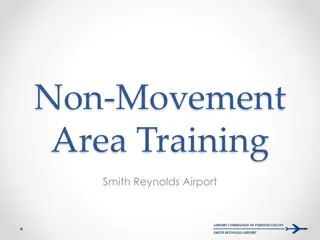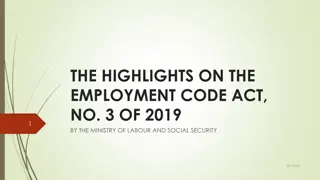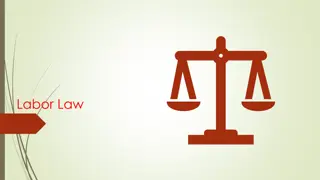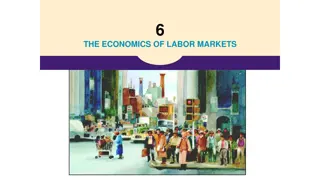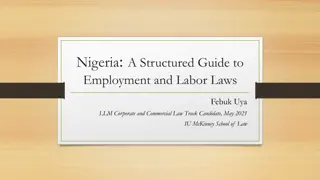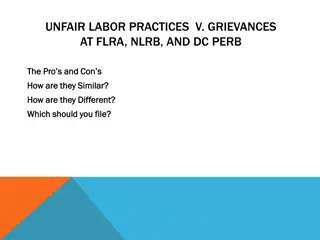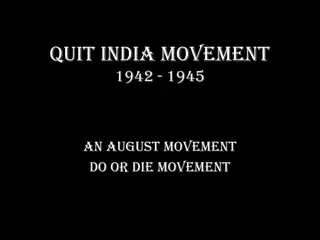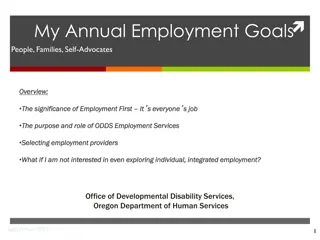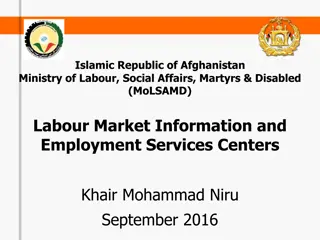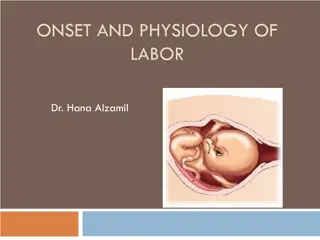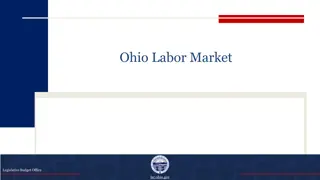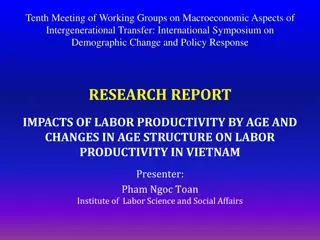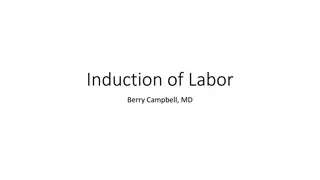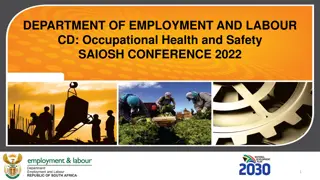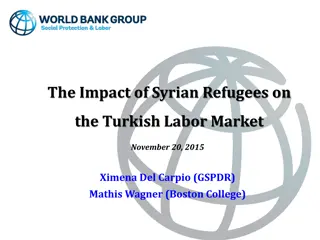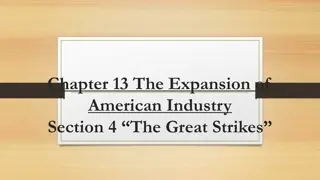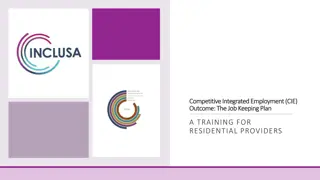#MeToo Movement: Impact and Response in Labor & Employment
The #MeToo movement has brought significant changes in the labor and employment landscape, especially in addressing sexual harassment. From increased lawsuits challenging harassment to employers reevaluating training programs and policies, the impact is profound. Employers are now rethinking investigation processes, implementing targeted training sessions, and revising reporting mechanisms to better handle harassment claims. The movement has pushed for accountability and proactive measures to prevent and address workplace harassment effectively.
Download Presentation

Please find below an Image/Link to download the presentation.
The content on the website is provided AS IS for your information and personal use only. It may not be sold, licensed, or shared on other websites without obtaining consent from the author.If you encounter any issues during the download, it is possible that the publisher has removed the file from their server.
You are allowed to download the files provided on this website for personal or commercial use, subject to the condition that they are used lawfully. All files are the property of their respective owners.
The content on the website is provided AS IS for your information and personal use only. It may not be sold, licensed, or shared on other websites without obtaining consent from the author.
E N D
Presentation Transcript
Penelope J. Phillips (612) 373-8428 pphillips@felhaber.com
2018 ANNUAL LABOR & EMPLOYMENT SEMINAR SEXUAL HARASSMENTINTHE #METOO ERA
#METOO MOVEMENT DEFINED #MeToo Movement: movement to increase awareness of sexual harassment and assault - SCOTUS, Minn. Voters All. v. Mansky, 138 S. Ct. 1876 (2018)
EEOC RECENT DEVELOPMENTS Proposed Enforcement Guidance on Unlawful Harassment Promising Practices for Preventing Harassment Guidance Checklists Leadership and Accountability Anti-Harassment Policy Harassment Reporting System and Investigations Compliance Training Risk Factors and Responsive Strategies
#METOO IMPACTON EEOC ENFORCEMENT IN FY 2018 50% increase in lawsuits challenging sexual harassment filed by EEOC 12%increase in charges alleging sexual harassment filed with the EEOC 1200 charges resulted in reasonable cause findings $70 million recovered for victims of sexual assault
WHAT ARE EMPLOYERS DOING IN RESPONSETO #METOO? Rethinking how they choose to investigate Anonymous online complaints? Harasser is a model employee ? Conduct off premises and after hours?
WHAT ARE EMPLOYERS DOING IN RESPONSETO #METOO? Reevaluating sexual harassment training programs and policies Live and online interactive trainings Targeted trainings for different levels of employees i.e., management, supervisors, employees
WHAT ARE EMPLOYERS DOING IN RESPONSETO #METOO? Revising reporting and investigation of sexual harassment claims Making it easier to make an internal complaint Improving HR s ability to investigate complaints Obtaining outside counsel to investigate complaints
WHAT ARE EMPLOYERS DOING IN RESPONSETO #METOO? Reviewing consensual relationship policies Upholding appropriate boundaries? Prohibiting or just discouraging manager/subordinate relationships? Right to modify reporting structures included? Prohibiting physical contact at work? Does it manage the risk of unlawful discrimination claims?
WHAT ARE EMPLOYERS DOING IN RESPONSETO #METOO? Opting for culture shifts Less alcohol and more food options at company events Actively engaging internal or external individuals to monitor suspicious and/or inappropriate behavior at company events
TOAVOIDLIABILITY EMPLOYERS MUST HAVE HARASSMENT POLICIES Having an easy to understand, comprehensive, and enforced harassment negotiable. It is the first step toward protecting employees from harassment. policy is non-
POLICY BASICS: EMPLOYEE RESPONSIBILITIES If an employee believes that he/she has been subject to inappropriate behavior, the employee must report the behavior so the employer investigation and stop the behavior if it is occurring. can conduct an
POLICY BASICS: EMPLOYER RESPONSIBILITIES If an employer receives a report of inappropriate behavior or the employer is aware or becomes aware of potentially inappropriate behavior, the employer must conduct an investigation and if the behavior is substantiated, it must take timely and appropriate action to stop the behavior.
EMPLOYER LIABILITY WHENA SUPERVISOR ISTHE HARASSER An employer will be held strictly liable for harassment if it is done by a supervisor and culminates in a tangible employment action. Burlington Indus., Inc. v. Ellerth, 524 U.S. 742 (1998); Faragher v. City of Boca Raton, 524 U.S. 775 (1998).
EMPLOYER LIABILITY WHENA SUPERVISOR ISTHE HARASSER Faragher/Ellerth Defense: If the supervisor s harassment does not culminate in a tangible employment action, the employer can avoid liability under the Faragher/Ellerth defense if it can show: It exercised reasonable care to prevent and promptly correct harassing behavior; and The complainant unreasonably failed to take advantage of preventative or corrective measures made available to her.
WHAT IS TIMELYAND APPROPRIATE ACTION? As soon as employer knows or should reasonably know that harassment may have occurred, the employer is required to take timely and appropriate action, including: A prompt, thorough, and fair investigation; Effective protective steps; and Monitoring.
WHAT EMPLOYERS MUST DO Train employees and supervisors on what behaviors constitute harassment in the workplace and what to do about harassment. Adopt a harassment policy that is enforced and accessible to employees. Know what constitutes a report of harassment. Investigate reports of harassment promptly and appropriately, and take appropriate corrective action. Save investigation report and documents collected. Continue to monitor the workplace to ensure that the harassment has stopped.
EEOC CHECKLIST: KEY ELEMENTSOF HARASSMENT POLICY Applies to employees at every level, applicants, clients, customers, etc. Prohibits harassment based on any legally protected class Describes prohibited conduct Encourages reporting and participation in investigations
EEOC CHECKLIST: KEY ELEMENTSOF COMPLAINT SYSTEM Multiple complaint avenues, including to report senior leaders Responsive to complaints Provides prompt, thorough, and neutral investigations Provides for follow-up with the complainant
EEOC CHECKLIST: TRAIN YOUR MANAGERS Not every employee comes forward and reports harassment. Managers must recognize harassment and when they are on notice about harassment.
TRAINING: WHAT IS A REPORTOF HARASSMENT? The standard is that the employer knew or should have known that harassment was occurring. For example, a report of harassment includes: An employee complains either orally or in writing about harassment toward them or another; A supervisor observes harassment; and/or Any other conduct or observation that puts the employer on notice that harassment has occurred.
HOW CANA REPORT BE COMMUNICATED? All manners of communication can convey a report of harassment. An employee has made a report regardless of whether it is by: E-mail, text message, note, letter, or memo; Phone call, hotline call, or voicemail; Snapchat, Tweet, or social media message or post; Sign language; Scribbles on a bathroom wall; or Other form of communication.
I DONT LIKE WORKING WITH . . . What should you do if an employee tells you that they don t like or feel comfortable working with a particular co-worker, supervisor, or customer? Follow up and ask why.
EXAMPLE: OTHER EMPLOYEES ARE BEING HARASSED Sheri often worked alone with her supervisor, Thomas. Thomas sexually harassed Sheri. He repeatedly and forcibly kissed Sheri on the lips, puller her against him, came up behind to massage her neck, and sent sexually-suggestive messages to her work computer. Although Sheri s employer had a written anti-harassment policy that she was asked to read and sign on her first day, she never reported the harassment. Why? Sheri knew Thomas was nasty, and with her daughter needing treatment for cancer, she could not take any chances on losing her job and health insurance.
EXAMPLE: OTHER EMPLOYEES ARE BEING HARASSED Thomas s conduct toward Sheri was not unique. During the holiday season each year, Thomas asked Sheri and other female employees to kiss him under the mistletoe. Thomas also hugged and kissed other female employees, and made unwanted physical advances toward women in authority positions, including the Chief Clerk and a Commissioner. Was there sufficient notice to the employer that the supervisor might be sexually harassing Sheri? The Third Circuit held that it was a jury question as to whether the employer exercised reasonable care to prevent and correct promptly any sexually harassing behavior because even though Sheri did not report the harassment, other people in authority positions knew that Thomas was harassing other women. Minarsky v. Susquehanna Cnty., 896 F.3d 303 (3d Cir. 2018)
#METOO IMPACTED THIRD CIRCUITS DECISION The Third Circuit explained that the #MeToo movement influenced its decision in Minarsky v. Susquehanna Cnty., 896 F.3d 303 (3d Cir. 2018): This appeal comes to us in the midst of national news regarding a veritable firestorm of allegations of rampant sexual misconduct that has been closeted for years, not reported by the victims. It has come to light, years later, that people in positions of power and celebrity have exploited their authority to make unwanted sexual advances. In many such instances, the harasser wielded control over the harassed individual s employment or work environment. In nearly all of the instances, the victims asserted a plausible fear of serious adverse consequences had they spoken up at the time that the conduct occurred.
#METOO IMPACTED THIRD CIRCUITS DECISION While the policy underlying Faragher-Ellerth places the onus on the harassed employee to report her harasser, and would fault her for not calling out this conduct so as to prevent it, a jury could conclude that the employee s non-reporting was understandable, perhaps even reasonable. That is, there may be a certain fallacy that underlies the notion that reporting sexual misconduct will end it. Victims do not always view it in this way. Instead, they anticipate negative consequences or fear that the harassers will face no reprimand; thus, more often than not, victims choose not to report the harassment.
AN EMPLOYEE MAKESA COMPLAINT WHAT SHOULDANEMPLOYER DO? Tell the employee you take his/her concerns seriously Don t minimize the behavior or be dismissive Don t ask if there are witnesses (yet) Do something!
EEOC PROPOSED GUIDANCE: INVESTIGATION DEPENDSON CIRCUMSTANCES An investigation is effective if it is sufficiently thorough to arrive at a reasonably fair estimate of truth. The investigation need not entail a trial-type investigation, but it should be conducted by an impartial party and seek information about the conduct from all parties involved. Conflicting versions of relevant events may require credibility assessments of witnesses.
EEOC PROPOSED GUIDANCE: EXAMPLEOF INADEQUATE INVESTIGATION Brandon, a construction worker, repeatedly complains to the superintendent that he is being sexually harassed by Phil, the foreman in charge of Brandon s crew. After about two weeks, the superintendent asks a friend of his to conduct an investigation, even though this individual is not familiar with EEO law or the harassment policy and has no experience conducting harassment investigations.
EEOC PROPOSED GUIDANCE: EXAMPLEOF INADEQUATE INVESTIGATION Another week later, the investigator contacts Brandon and Phil and meets with them individually for about 10 minutes each. During the meeting with Brandon, the investigator never asks him any questions and does not take any notes. Without first consulting with the EEO office, the investigator issues a single-page memorandum concluding that there is no basis for finding that Brandon was sexually harassed, but does not provide any explanation. Under these circumstances, the employer has not conducted an adequate investigation.
RECENT EEOC SETTLEMENT EXAMPLE: INADEQUATE INVESTIGATION Male and female customer service employees reported sexual harassment by managers and coworkers to onsite HR staff. HR failed to: Adequately investigate the complaints Adequately discipline the harassers Follow complaint procedures Take sexual harassment complaints seriously HR also actively deterred employees from making sexual harassment complaints. Result: The EEOC brought suit against the employer, and the parties agreed to a $3.5 million settlement. EEOC v. Alorica, Inc., No. 17-1270 (July 31, 2018)
EXAMPLE: TELLING EMPLOYEETODEAL WITH IT Cole was a male truck driver who was harassed by his co- worker, Dan, for five years. Dan harassed Cole by: repeatedly lying to new employees by telling them that Cole was gay, even though he was not; put Cole in a headlock and pretended to kiss him; brushed Cole s buttocks with his hands; rubbed his genitals on Cole s arm; showed Cole pornographic images on his phone; and pinched his nipples, among other harassing conduct. 34
EXAMPLE: TELLING EMPLOYEETODEAL WITH IT Cole s supervisors knew about the harassment, but told him to deal with it. After one particularly egregious touching, Cole reported the harassment to his supervisors. A week later, the employer laid Dan off. Cole then had to drive Dan s truck which smelled of Dan s body odor and work an extra night a week. Someone from upper management commented to Cole that he was glad that the harassment did not happen to a female. Jury verdict: $2.6 million in favor of employee. Hudson v. Beverly Fabrics, Inc., No. CISCV182035 (Cal. 2018). 35
HOW DO YOU CONDUCT AN INVESTIGATION? Select an appropriate investigator Gather policies and procedures Figure out what happened Take appropriate corrective action
STEP ONE: SELECT AN APPROPRIATE INVESTIGATOR Analytical: detail-oriented, gather and organize facts efficiently and effectively, and make recommendations Trusted: handles confidential/sensitive information in appropriate and professional manner Credible: trusted and skilled in investigative role, well- respected Objective: acknowledges own biases and avoids allowing them to affect judgment Knowledgeable about discrimination/harassment: understands legal implications and actionable conduct Personable: welcoming and listens to each person to share story Neutral: no connections with parties
WHENTO CONSIDERA THIRD PARTY INVESTIGATOR The person accused holds a high-level leadership position The people who would typically investigate the complaint are either involved or cannot remain neutral The complaint involves issues that HR does not have the right experience and training to handle
STEP TWO: GATHER POLICIESAND PROCEDURES Gather, at a minimum: Discrimination policy EEO policy Harassment policy Whistleblower and retaliation policy Code of Conduct Union contracts (grievance procedures, conduct standards)
STEP THREE: FIND OUT WHAT HAPPENED Collect facts and relevant evidence Determine witnesses and involved individuals Determine who, what, when, where, why, and how Evaluate credibility Identify and eliminate extraneous information
STEP FOUR: APPROPRIATE CORRECTIVE ACTION Make a decision for appropriate corrective action Any discipline should be prompt and proportionate to the behavior(s) at issue and the severity of the infraction, and be consistent with discipline of other employees No retaliation
EXAMPLE: DISCIPLINETHE HARASSER APPROPRIATELY David worked at a steel plant with a co-worker named John. John made sexual comments to David, and inappropriately touched him. David complained to his manager and HR, and was transferred to another part of the plant so he would no longer work directly with John. HR disciplined John for his behavior with a verbal warning, a one-week suspension, a demotion, and required him to take a leadership class. The harassment stopped. HELD: No employer liability because the employer s response was adequate, noting that a response is adequate if it is reasonably calculated to end the harassment. Hylko v. Hemphill, 698 Fed. Appx. 298 (6th Cir. Oct. 3, 2017).
EEOC PROPOSED GUIDANCE: INTERMEDIATE ACTION When serious allegations have come forward, what intermediate steps to address the situation should the employer take while it determines whether a complaint is justified? Consider taking the following measures: Scheduling changes to avoid contact between the parties; Temporarily transferring the alleged harasser; or Placing the alleged harasser on non-disciplinary leave with pay pending the conclusion of the investigation.
EEOC PROPOSED GUIDANCE: INTERMEDIATE ACTION As a rule, employers should make every reasonable effort to minimize the burden or negative consequences to an employee who complains of harassment, pending the employer s investigation.
WHAT SHOULD YOU DO IF EMPLOYEES ARE BEING HARASSED BY CUSTOMERS? Investigate the complaint in the same way the employer would if an employee was the harasser Take action to stop the harassment depending on the circumstances, which may include: Informing the customer that they will be banned if they continue harassment. Banning the customer. Finding a way that the employee will not need to deal with that customer. Do not retaliate against the employee.
TRAININGFOR EMPLOYERS Training must be emphasized at the organizational level, at the employee level, and at the supervisor and manager level.
EEOC CHECKLIST: TRAININGAT ORGANIZATIONAL LEVEL Championed by senior leaders Repeated and reinforced regularly Provided to employees at every level and location of the organization Conducted by qualified, live, interactive trainers If live training is not feasible, designed to include active engagement by participants
EEOC CHECKLIST: TRAININGAT EMPLOYEE LEVEL Examples tailored to the specific workplace and workforce Information about employees' rights and responsibilities if they experience, observe, or become aware of conduct that they believe may be prohibited Encourages employees to report harassing conduct
EEOC CHECKLIST: TRAININGAT MANAGER LEVEL Information regarding how to prevent, identify, stop, report, and correct harassment Risk factors and specific actions that may minimize or eliminate risk of harassment Explains consequences of failing to fulfill their responsibilities related to harassment, retaliation, and other prohibited conduct
KEY TAKEAWAYS Bottom Line An employer cannot absolutely control what happens at every location at all times of the work day. What employers must do: Have sexual harassment policies and other types of harassment policies in order. Provide an appropriate response when claims are reported, including an investigation when warranted. Take effective remedial action when misconduct is determined. Prohibit discrimination and harassment based on other protected classes beyond sex.



